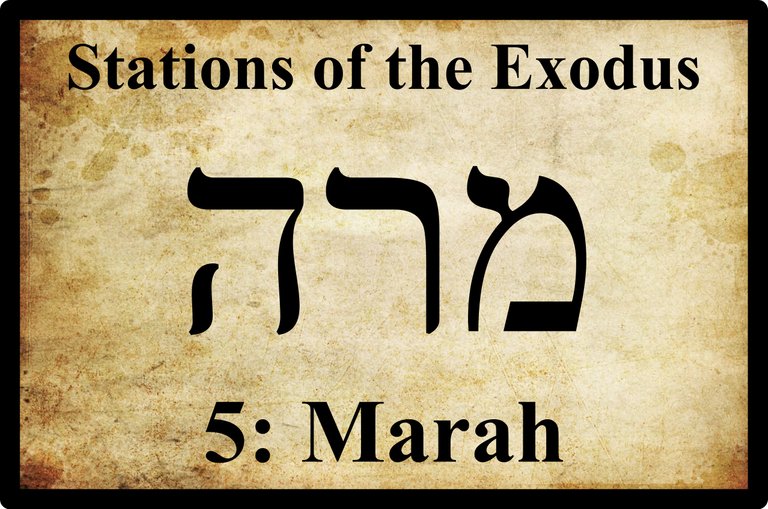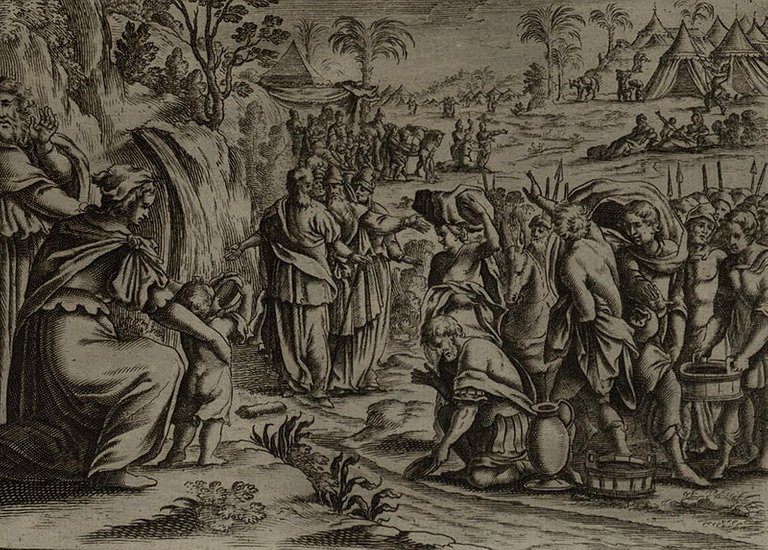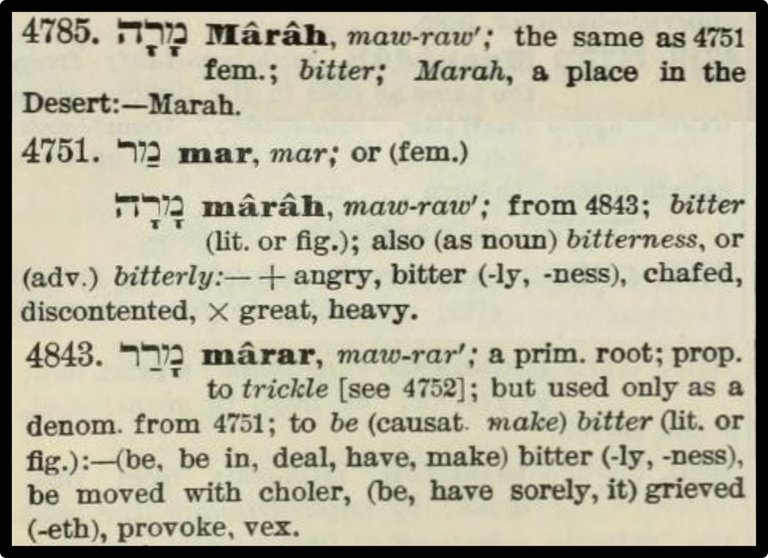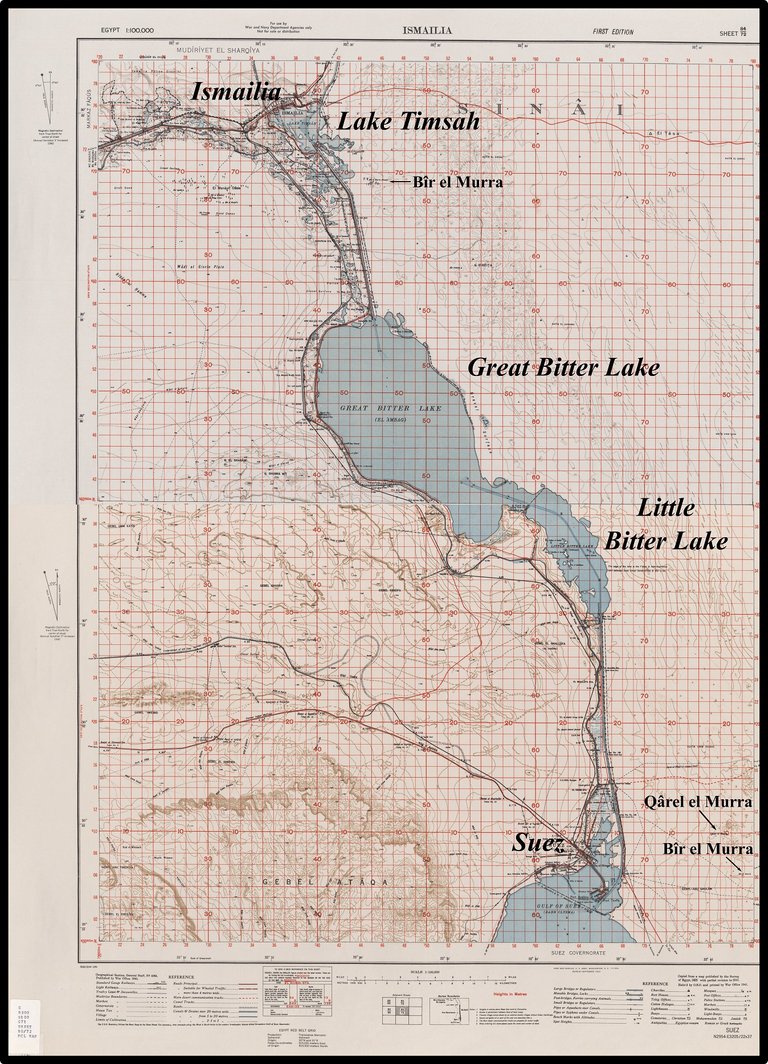
The Fifth Station of the Exodus is called Marah. In Numbers 33:8 we are told very briefly:
And they departed from before Pihahiroth, and passed through the midst of the sea into the wilderness, and went three days’ journey in the wilderness of Etham, and pitched in Marah. And they removed from Marah, and came unto Elim: and in Elim were twelve fountains of water, and threescore and ten palm trees; and they pitched there. (Numbers 33:8-9)
Note that we are specifically told that the fourth and fifth stations were separated by a three days’ journey. This refutes my hypothesis that the 42 Stations of the Exodus represented the nightly stopovers of the Israelites, with the entire journey from Egypt to Canaan taking not 40 years but 42 days. But perhaps we can still assume that two successive stations are separated by only a single day’s march unless we are specifically told otherwise. On the other hand, if Numbers 33 is based on a simple list of the 42 Stations of the Exodus, it is possible that every reference to the passage of time is a later accretion.
In the Book of Exodus, this episode is also recounted briefly, with few details to help us locate Marah:
So Moses brought Israel from the Red sea, and they went out into the wilderness of Shur; and they went three days in the wilderness, and found no water. And when they came to Marah, they could not drink of the waters of Marah, for they were bitter: therefore the name of it was called Marah. And the people murmured against Moses, saying, What shall we drink? And he cried unto the Lord; and the Lord shewed him a tree, which when he had cast into the waters, the waters were made sweet: there he made for them a statute and an ordinance, and there he proved them, And said, If thou wilt diligently hearken to the voice of the Lord thy God, and wilt do that which is right in his sight, and wilt give ear to his commandments, and keep all his statutes, I will put none of these diseases upon thee, which I have brought upon the Egyptians: for I am the Lord that healeth thee. And they came to Elim, where were twelve wells of water, and threescore and ten palm trees: and they encamped there by the waters. (Exodus 15:22-27)
According to Numbers, after passing through the sea, the Israelites found themselves in the wilderness of Etham. In Exodus this waste is called the wilderness of Shur. As we saw in an earlier article in this series, these are clearly two names for the same place—the lowlying desert of northern Sinai, which lies to the east of Egypt, between the Tih Plateau and the Mediterranean coast. So there is no real discrepancy between these two accounts.
In the previous article, I identified the Sea of Passage with a narrow neck of water in the northern part of Lake Ballah. With this as our premise, let us see if we can find Marah somewhere to the east or south-east of this lake (which, of course, no longer exists).

Marah
In Volumes 3 and 5 of the International Standard Bible Encyclopedia, we read:
Marah, māʹra, märʹa, (מׇרׇה, mārāh, “bitter”): The first camp of the Israelites after the passage of the Red Sea (Ex 15 23; Nu 33 8 f. The name is derived from the bitterness of the brackish water. Moses cast a tree into the waters which were thus made sweet (Ex 15 23) ...
The site of Marah seems clearly to have been at ‘Ain Ḥawârah (“the white chalk spring”), named from the chalky mound beside it. This is 36 miles [58 km] from ‘Ayyûn Musa, giving an average daily march of 12 miles [19 km]. There is no water on the route, though some might have been fetched from ‘Ain Abu Jerâd in Wâdy Sudr, and from the small spring of Abu Suweirah near the sea. Burckhardt thought that the water was sweetened from the berries of the Gharḳad shrub (which have an acid juice) on the thorny bushes near the spring. This red berry ripens, however, in June. There is no doubt, on the other hand, that the best treatment for brack water is the addition of an acid taste. The Arabs consider the waters of this spring to be the most bitter in the country near (Orr 3:1984, 5:3066)
As the authors have already decided that the Sea of Passage was the Red Sea, it is only natural that they should seek Marah some distance south of Suez. ‘Ain Ḥawârah lies about 76 km southeast of Suez—nowhere near our Sea of Passage on Lake Ballah. William Gesenius’s A Hebrew and English Lexicon of the Old Testament also identifies Marah with ‘Ain Ḥawârah (Brown, Robinson & Gesenius 600), as does Easton’s _Bible Dictionary (Easton 1897:762) and William Smith’s A Dictionary of the Bible (Smith 378).
Another site in this part of Sinai, but closer to Suez, has also been suggested, as mentioned in The Jewish Encyclopedia:
MARAH (lit. “bitter”) : The name of a station or halting-place of the Israelites in the wilderness (Ex. XV. 23; Num. xxxiii. 8), so called in reference to the water of the well found there. It was reached by the Israelites three days after crossing the Red Sea and after they had passed the valley of Shur and the wilderness of Athan. The well is variously identified with ‘Ayun Musa, ‘Ain Naba, or Al-Gharḳadah (comp. Holzinger, “Exodus,” p. 55; Dillmann, “Exodus,” p. 177) (Singer 318)
‘Ayun Musa, or the Wells of Moses, is a brackish oasis about 15 km southeast of Suez. According to August Dillmann’s commentary on the Book of Exodus, ‘Ain Naba and Al-Gharḳadah both refer to another well about 5 km (1 Wegstunde = 1 league) north of ‘Ayun Musa. (Dillmann 178). These are certainly closer to our Sea of Passage, but probably still too far away to be reached in three days. Note that on page 180, Dillmann glosses 4 Stunden as 13 km, which seems to imply that he considers a league to be about 3.25 km, not the usual 5 km.
In Strong’s Exhaustive Concordance of the Bible, Marah is Number 4785. In the accompanying Hebrew and Chaldee Dictionary, it is interpreted as meaning bitter, but it is identified only as a place in the desert (Strong 72).

James K Hoffmeier, who also locates the Sea of Passage in the northern part of Lake Ballah, has suggested that after crossing the Sea of Passage, the Israelites could have covered as much as 96 km in the three days before they reached Marah:
The Israelites would have traveled south from the crossing area on the northern portion of the Ballah Lakes. Using thirty-two kilometers (twenty miles) as the approximate distance for the average day’s journey (see chapter 6, §III), they would have traveled past the Bitter Lakes, approximately ninety-six kilometers (sixty miles), which would land them in the area of present-day Suez, that is, the northern end of the Gulf of Suez. (Hoffmeier 161)
To be precise, this would land the Israelites somewhere north of Suez. Note that the authors of the International Standard Bible Encyclopedia estimate the average day’s journey of the Israelites to have been only 19 km (Orr 5:3066). In an earlier article in this series (Part 18), I surmised that the Israelites could have covered 19-35 km in one day.

August Dillmann
In his extensive commentary on the Book of Exodus, the German theologian August Dillmann records no fewer than five possible candidates for Marah:
- The Bitter Lakes
- ‘Ain Ḥawârah, 80 km south of ‘Ayun Musa
- Wadi el ‘Amâra, 10 km north of ‘Ain Ḥawârah
- Wadi Gharandel, 10 km south of ‘Ain Ḥawârah
- ‘Ain Nâba or el Gharqada, 15 km east-southeast of Suez, or 5 km north of ‘Ayun Musa
He rejects the Bitter Lakes (Brugsch 241) as not fitting any of the statements in the text—and they were probably still part of the Gulf of Suez at the time of the Exodus. He cites the German explorer Ulrich Jasper Seetzen to the effect that ‘Ain Ḥawârah had not enough water to feed the Israelites—but was that also the case 2500 years before Seetzen’s time? He describes Wadi el ‘Amâra as a barren valley. Wadi Gharandel, he comments, would have had ample water for the Israelites, but the water is not actually bitter. He also notes that these three places have been variously identified with Marah on the assumption that the Sea of Passage was the Red Sea in the vicinity of the modern city of Suez. If, however, Lake Timsah is identified with the Sea of Passage, then ‘Ain Nâba (el Gharqada) would better fit the Bible’s three days’ journey to Marah, with ‘Ayun Musa being a good fit for the next station, Elim.
Dillmann’s final conclusion is that due to the uncertainty surrounding the identity of the Sea of Passage, Marah cannot yet be identified with any confidence. (Dillmann 177-178)
If we accept Hoffmeier’s 90 km or so for the three days’ journey from Lake Ballah to Marah, and if we assume that the Israelites travelled south alongside the Gulf of Suez, then we should be looking for Marah in the vicinity of Suez. In a previous article in this series, we saw that at the time of the Exodus the Red Sea probably reached as far north as Lake Timsah. The Great and Little Bitter Lakes did not yet exist. Nevertheless, Marah may very well have been in the vicinity of the later Little Bitter Lake, the southern extremity of which is about 20 km north of Suez.
If, on the other hand, we restrict the daily march of the Israelites to about 20 km, then a three days’ journey from Lake Ballah was take them about half-way past the Great Bitter Lake, or 40 km north of Suez. I have, however, not been able to find any suitable candidates for Marah along this stretch.
Proceeding a little further south, however, we begin to come upon plausible candidates. On the Great Britain War Office map of Egypt, there are two wells to the east of Suez with interesting names:
- Qârel el Murra
- Bîr el Murra
Could either of these be the Biblical Marah? Actually, I am not the first to suggest this. In my research I came across the following passage in Clinton Bailey’s Bedouin Culture in the Bible:
Owing to the cultural continuity discernible in the method of naming desert places both among the Bedouin and in the Bible, there is at least a slight probability of identifying the location of some places mentioned in the latter. For example, when entering Sinai, the first water sources the Israelites come upon—Bitter Water (Marrah) and the oasis Elim, the meaning of whose name is unknown, but which “contained twelve springs and some palm trees” (Exod. 15:23, 27)—greatly resemble what the Bedouin presently call Bir al-Murra, which contained twelve springs and a cluster of date palms when visited by the British scholar Henry Palmer in the 1860s. (Bailey 49)
Qârel el Murra is only about 4 km north of Bir el Murra, so if the latter is Elim, we would probably need to look much further north for Marah. Although the Israelites are unlikely to have only covered 4 km in one day, this is not entirely beyond the bounds of credibility. Imagine the following scenario:
The Israelites travel for three days in the Wilderness of Etham without water
They arrive at Qârel el Murra and pitch camp, only to discover that the water is bitter
They leave Qârel el Murra the next day
After 4 km, they arrive at Bîr el Murra, an oasis with potable water and date palms
They pitch camp again, even though they have only made 4 km since the previous day
Such a scenario would be all the more plausible if we discount as a later myth the story of Moses pacifying the murmuring Israelites at Marah by miraculously sweetening the bitter waters. If they did not find potable water at Marah, then they would surely have stopped at the oasis of Elim even if it was only a few kilometres away. Against this hypothesis, however, is the fact that Qârel el Murra is about 100 km south of our Sea of Passage. It is not impossible that the Israelites could have covered such a distance in three days: my upper estimate of 35 km per day would allow them cover as much as 115 km in three days. If they were running short of water, it makes sense that they would have covered as much ground as possible.
There is another well called Bîr el Murra: it lies about 11 km southeast of Ismailia, or close to the southeastern corner of Lake Timsah. This is only about 30 km from our Sea of Passage, so it certainly could have been reached within three days—if not in one or two days. If this were Marah, though, it would severely constrain our choice of candidates for Elim. The two places called Bîr el Murra are separated by about 72 km, so they cannot be identified with Marah and Elim respectively.
In the Jewish Study Bible, Jeffrey H Tigay suggests that the southern Bîr el Murra may be the Biblical Marah:
Marah, lit. “bitter.” Brackish pools and wells are common in deserts (d. the “Bitter Lakes” in the Isthmus of Suez). Assuming that the Israelites are now heading south, the site could be Bir el-Murrah, Arabic for “Bitter Well,” nine miles [15 km] east of Suez, or the oasis Ein Hawarah, 75 km (47 mi) southeast of Suez, near Wadi Amarah which has a similar sounding name. (Berlin & Brettler 138-139)

Bîr is the Arabic for well, but I have not been able to discover what Qârel means. It seems to be a personal name.
Legends of the Jews
In support of the hypothesis that Qârel el Murra and the southern Bîr el Murra represent Marah and Elim respectively, one might cite Louis Ginzberg’s The Legends of the Jews. In this work the transformation of the bitter water of Marah into sweet is explicitly described as a miraculous event:
For three days they marched through the desert, uncomplaining, but when their supply of water gave out, the people murmured against Moses, saying, “What shall we drink?” ... The people were all the more exasperated because their joy, when they sighted the springs and hastened to draw from them, turned to keenest disappointment when they tasted of the water and found it bitter ... While they indulged in these lamentations, Moses prayed to God to forgive the faint of heart their unseemly words, and, furthermore, to supply the general want. Mindful of the distress of the people, Moses did not pray long, but uttered his request in a few words; and quickly, as he had prayed, was his prayer answered. God bade him take a piece of a laurel tree, write upon it the great and glorious name of God, and throw it into the water, whereupon the water would become drinkable and sweet.
The ways of the Holy One, blessed be He, differ from the ways of man: Man turns bitter to sweet by the agency of some sweet stuff, but God transformed the bitter water through the bitter laurel tree. When Israel beheld this miracle, they asked forgiveness of their heavenly Father, and said : “O Lord of the world ! We sinned against Thee when we murmured about the water.” Not through this miracle alone, however, has Marah become a significant spot for Israel, but, especially, because there God gave to Israel important precepts, like the Sabbath rest, marriage and civil laws, (Ginzberg 38-39)
Against this, one might note that the sweetening of bitter water in the desert does not actually require a miracle:
Even today, Bedouin sweeten brackish water with shrubs that cause the salt to sink to the bottom. (Berlin & Brettler 139)
Conclusion
As August Dillmann noted, the identity of Marah remains uncertain to this day. As a working hypothesis, however, I will tentatively identify it with either Qârel el Murra or Bîr el Murra, about 15 km east of Suez. I will look for Elim further south, but if a more northerly candidate presents itself, I may have to revisit my identification of Marah. It should also be remembered that the three days’ journey from the Sea of Passage to Marah may be a late addition to a simpler narrative in which the journey took just one day.
To be continued ...
References
- Clinton Bailey, Bedouin Culture in the Bible, Yale University Press, New Haven CT (2018)
- Adele Berlin & Marc Zvi Brettler (editors), _The Jewish Study Bible , Jewish Publication Society TANAKH Translation, Oxford University Press, Oxford (1999)
- Francis Brown, Edward Robinson, William Gesenius, A Hebrew and English Lexicon of the Old Testament, Clarendon Press, Oxford (1906)
- Heinrich Karl Brugsch, The True Story of the Exodus of Israel, Edited with an Introduction and Notes by Francis H Underwood, Lee and Shepard Publishers, Boston (1880)
- August Dillmann, Die Bücher Exodus und Leviticus, S Hirzel, Leipzig (1897)
- Matthew George Easton, A Dictionary of Bible Terms, Thomas Nelson, Edinburgh (1897)
- Louis Ginzberg, The Legends of the Jews, Volume 3, Translated from the German by Paul Radin, The Jewish Publication Society of America, Philadelphia (1911)
- James K Hoffmeier, Ancient Israel in Sinai: The Evidence for the Authenticity of the Wilderness Tradition, Oxford University Press, Oxford (2005)
- Heinrich Holzinger, Exodus: Erklärt von H Holzinger, Kurzer Hand-Commentar zum Alten Testament, Volume 2, J C B Mohr, Tübingen (1900)
- James Orr (General Editor), The International Standard Bible Encyclopedia, Volume 3, Volume 5, The Howard-Severance Company, Chicago (1915)
- Edward Henry Palmer, Desert of the Exodus: Journeys on Foot in the Wilderness of the Forty Years’ Wanderings, Deighton, Bell, and Co, Cambridge (1871)
- Isidore Singer (managing editor), The Jewish Encyclopedia, Volume 8, Funk & Wagnalls Co, New York (1905)
- William Smith, _A Dictionary of the Bible _, D Lothrop & Co, Boston (1880)
- James Strong, The Exhaustive Concordance of the Bible, Eaton & Mains, New York (1890)
Image Credits
- Moses Sweetening the Waters of Marah : Gérard Jollain (engraver), La Saincte Bible (1670), Public Domain
- Strong 4785: Marah: James Strong, A Concise Dictionary of the Words in the Hebrew Bible, Eaton & Mainz, New York (1890), Public Domain
- Candidates for Marah: University of Texas Libraries, Perry-Castañeda Library Map Collection, US Army Map Service (1959), Public Domain
- Bîr el Murra: University of Texas Libraries, Perry-Castañeda Library Map Collection, Great Britain War Office (1941), Public Domain

Hello great friend spectacular story very interesting that good that this back to the community many success I will always support you with post of such quality
Wow! Such a wonderful history and very nice article. thank you For sharing with us...
Hello brother @harlotscurse good post given go ahead have a nice day...?♥
Very good historical post dear